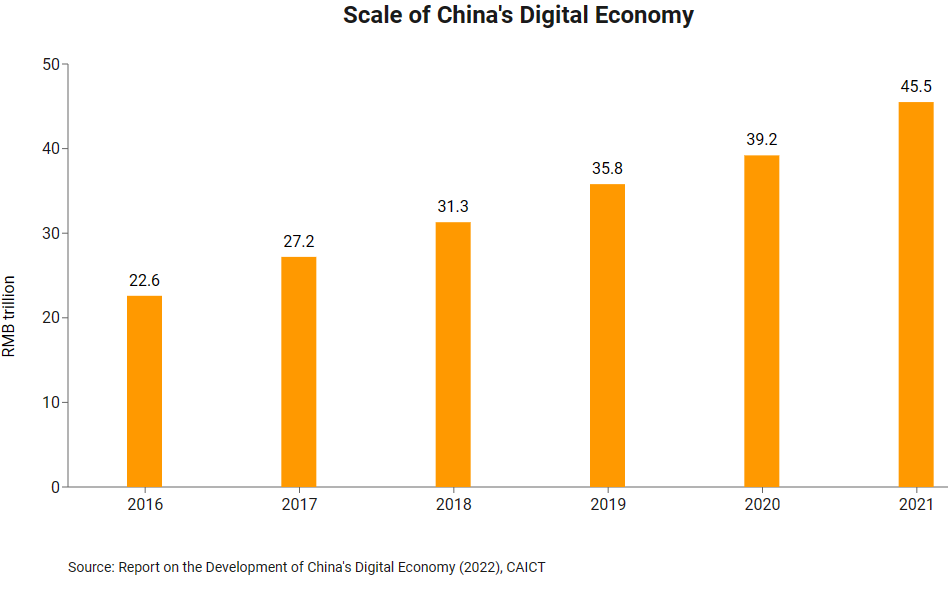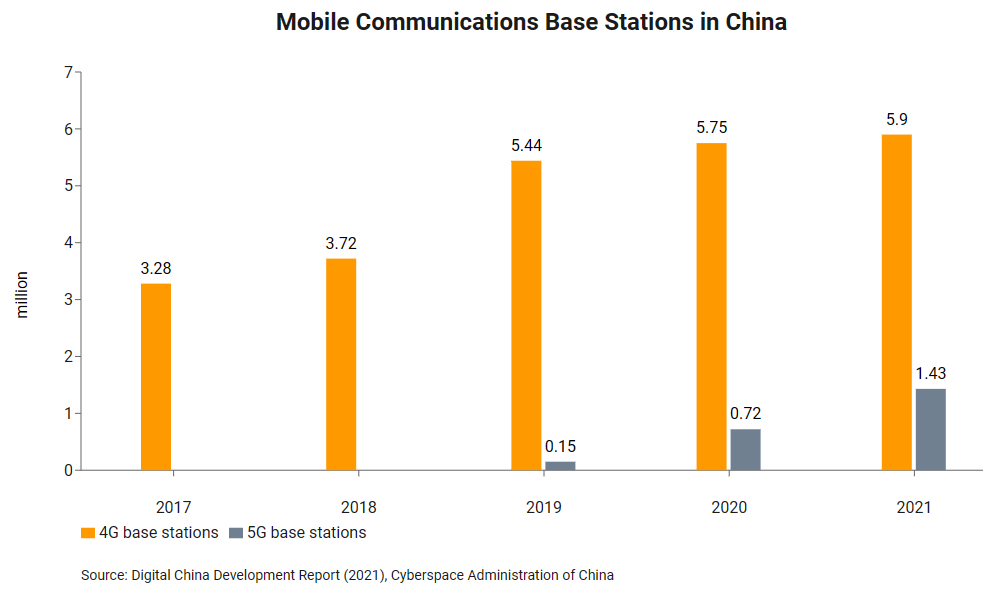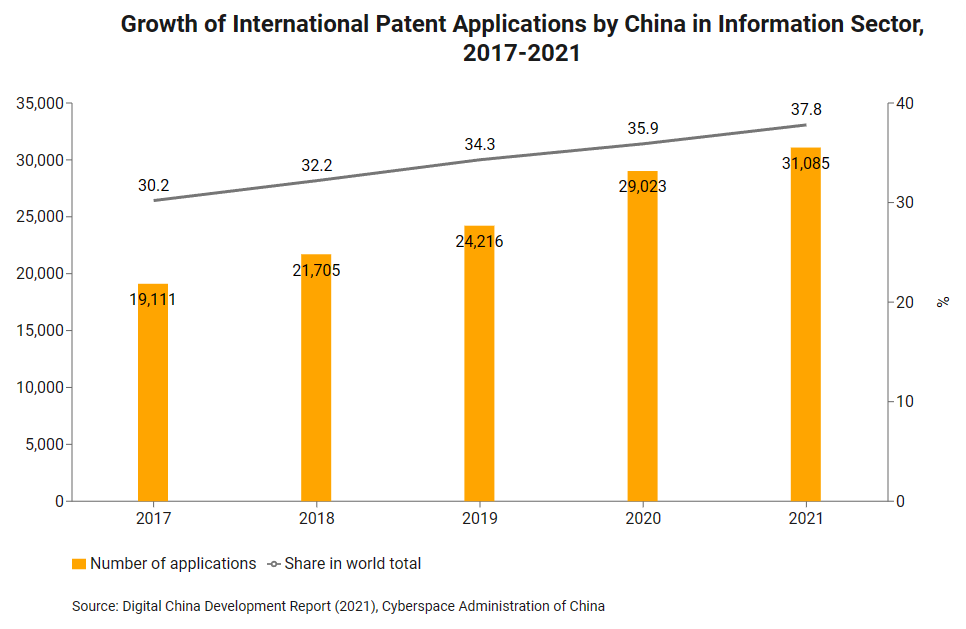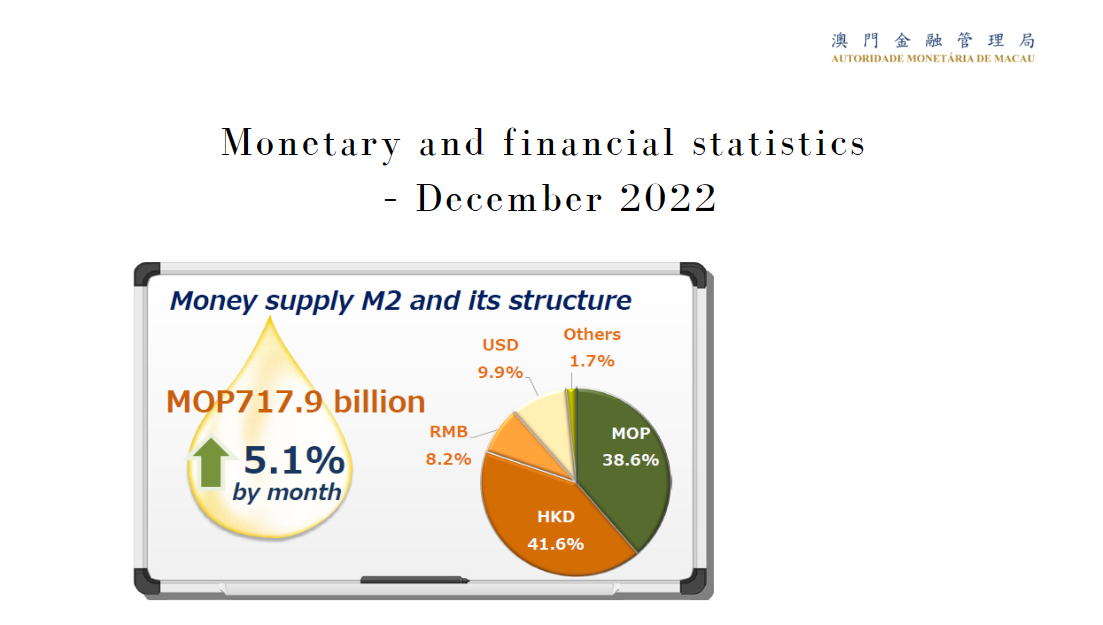China's Digital Economy: Full Steam Ahead
Generally speaking, the term “digital economy” refers to the use of big data and digital information as the key factors of production to create a new economic system by using advanced digital technology and optimising economic structure. The main driving forces behind the development of the digital economy are digital industrialisation (i.e. turning the telecommunications, information technology and internet industries into pillar industries) and industrial digitalisation (i.e. upgrading traditional industries, including ‑ but not limited to ‑ the use of new technologies such as artificial intelligence, blockchain, and the Internet of Things).
In Hong Kong, the Financial Secretary announced in the government's budget for the 2022‑23 fiscal year that a Digital Economy Development Committee will be established to promote the development of the digital economy in Hong Kong. It aims to expedite and guide the growth of the digital economy as well as lay a sound foundation for the sustainable transformation and upgrading of Hong Kong’s economy in the years ahead. In order to help Hong Kong companies capture opportunities arising from the development of the digital economy on the mainland, this article discusses China’s digital economy in terms of its current supporting infrastructure and favourable policies.
China as global leader
Scale of China’s digital economy
China’s digital economy has been growing rapidly and plays a key role in the new global economic structure. According to the latest White Paper on Global Digital Economy (2022) released by the China Academy of Information and Communications Technology (CAICT), the added‑value of the digital economy of 47 major countries reached US$38.1 trillion in 2021. The biggest digital economy in the world was that of the US at US$15.3 trillion, with China second on US$7.1 trillion. In spite of the blow dealt by Covid-19, China’s digital economy has not only continued to grow, but has also achieved new breakthroughs in recent years. The Report on the Development of China's Digital Economy (2022) published by CAICT pointed out that the size of the country’s digital economy more than doubled between 2016 and 2021, growing from RMB22.6 trillion to RMB45.5 trillion and accounting for 39.8% of GDP by the end of the five‑year period.

Digital infrastructure
As the cornerstone of the development of the digital economy, advanced infrastructure facilities such as a 5G network and data centres are key projects as well as important engines driving economic growth in various countries. China’s digital infrastructure is the largest in the world.
According to the Digital China Development Report (2021) released by the Cyberspace Administration of China (CAC), by the end of 2021 1.425 million 5G base stations had been built in China, accounting for more than 60% of the world’s total; the number of 5G mobile phone users in China reached 360 million; the country’s internet penetration rate rose from 42.1% in 2012 to 73% in 2021; and the number of internet and mobile phone users reached 1 billion and 1.6 billion respectively. All these figures indicate that the information and communications services provided to and used by people in China have increased markedly. The general public have access to advanced telecommunications networks and can enjoy greater convenience and quality of life thanks to the digitalisation of society.

China also has a sound big data industry chain stretching from data collection and provision to data service and data application (e.g. in sectors such as smart logistics and fintech). In terms of the supply of hardware such as data processing and storage, the Ministry of Industry and Information Technology (MIIT) revealed at the 2022 China Computational Power Conference that, as of 2021, there were a total of 5.2 million racks and 19 million servers in data centres across China, with a storage capacity amounting to 800EB1. At the same time, great efforts are being devoted by China to optimising the facilities of these data centres in a move to build a “national integrated big data centre”, which will provide stable data to sectors such as fintech and cloud computing. For instance, in February 2022 China launched projects on channelling computing resources from the eastern to the western regions, which will see eight national data processing hubs built in the Guangdong‑Hong Kong‑Macao Greater Bay Area (GBA), Chengdu and Chongqing, while another 10 national data centre clusters are planned. The National Development and Reform Commission (NDRC) has projected that during the 14th Five‑Year Plan period, investment in big data centres will increase over 20% a year, pushing up cumulative investment in the digital economy to over RMB3 trillion. The size of China’s big data industry also grew rapidly, from RMB470 billion in 2017 to RMB1.3 trillion in 2021. The services provided by this industry mainly cater to various applications and market demands, including data exchange and data processing and analysis. Evidently, China already has in place a steady source of big data resources for the development of the digital economy.
Digital innovation
China ranked 11th in the Global Innovation Index 2022 created by the World Intellectual Property Organisation (WIPO). Among the top science and technology innovation clusters in the world, China’s Shenzhen‑Hong Kong‑Guangzhou ranked second and Beijing ranked third.
Regarding intellectual property and invention patents in the digital arena, development in China is already quite mature. The Digital China Development Report (2021) pointed out that by the end of 2021 the number of valid invention patents in China’s digital economy core industries had reached 977,000, a more than twofold increase over 2016, and accounted for 35% of the country’s total valid invention patents. According to the China National Intellectual Property Administration, by July 2022 computer technology, measurement and digital communications were the three leading sectors in terms of the number of valid invention patents in the country. On the information front, in 2021 China filed over 30,000 international applications for patents under the Patent Cooperation Treaty (PCT), accounting for over one third of the world’s total. In particular, a total of 440,000 artificial intelligence (AI) patent applications were filed by China between 2018 and 2021, making it the world leader in terms of numbers. As science and technology continue to advance and China invests heavily in the R&D of digital technology, it is likely that the strength of China’s invention patents in this sector will continue to rise, prompting its economy and society to move further towards digital transformation.

As China has a huge start‑up ecosystem, innovation and technology in the digital sector have become the mainstay of the country’s start‑up companies. According to the Global Unicorn Index 2022 Half-Year Report released by the Hurun Research Institute, as of June 2022 China ranked second in the world behind the US with 312 unicorns, most of which were in the health sciences, AI, e‑commerce, and semiconductor industries. The GBA, one of the core regions in China for the development of the digital economy, was home to a total of 62 unicorns, almost double the number in 2020. Many of these new companies were engaged in information technology and high‑end manufacturing. This shows that China has been enhancing its capabilities in proprietary digital R&D and devoting great efforts to advancing digital industrialisation.
Government support
Support policies
To encourage the development of the new economy, the Chinese government has issued documents on a series of support policies aimed at promoting the digitalisation of society and creating a new era of Digital China. It has also made continuous efforts to widen and improve policies aimed at promoting the digital economy.
The plan for the development of the digital economy during China’s 14th Five‑Year Plan period issued by the State Council in 2021 clearly stated that the digital economy is the country’s main economic pillar after agriculture and industry. The country’s target was that by 2025 its digital economy would be expanding on all fronts and it was expected that the added‑value of the core industries of the digital economy would account for 10% of GDP.
At the local level, according to the Report on the Development of China's Digital Economy (2022), provincial and municipal governments across the country implemented a total of 216 policies in 2021 in different sectors related to the digital economy. For instance, the Beijing municipal government built a high‑level automated driving demonstration area in 2020, taking the lead in allowing the new technologies and products of self‑driving car companies to be used on certain highways. As of 2021, the Beijing municipal government had given the green light to about 225 autonomous cars from nine companies to test drive on the road, covering an aggregate of over 3 million km. This is a good example of how the government is pushing forward industrial digitalisation.
Preferential policies
In the GBA, great efforts have been made to introduce preferential policies to promote the digital economy. In April 2022, Guangzhou’s Huangpu district government took the lead in introducing the 10 Measures for Promoting Metaverse, covering such areas as technological innovation and intellectual property protection. Under these measures, outstanding metaverse‑related companies establishing a foothold in the district would be granted a rent subsidy of up to RMB1 million and financial assistance of up to RMB5 million to buy business premises. These flexible government policies can effectively help to raise the level of digitalisation in various provinces and cities.
The Chinese government has also been actively encouraging industries across all sectors to pursue digital transformation, and helping traditional industries raise their level of “going smart”. In April 2022, the Department of Investment under the NDRC asked 12 trade associations to recommend digital transformation projects for investment and construction in 2022. The department said that financial support would be given to projects for their preliminary work towards digitalisation. For instance, funding would be granted to enterprises engaged in heavy industry and agriculture to help them set up production management processes, build data models, and apply SaaS (cloud services). The expectation was that this would motivate them to pursue digital transformation.
In November 2022, the MIIT issued a set of guidelines to facilitate the digital transformation of small and medium‑sized enterprises (SMEs) and announced a number of measures aimed at lowering the threshold for the digital transformation of SMEs. These measures, which follow the introduction of an equipment purchasing and upgrading relending facility by the People’s Bank of China in September, include government actions to broaden the financing channels for SMEs by setting up a special SME digital transformation loan as well as encouraging financial institutions to develop special products and services. The government has also launched a digital transformation consultation service inviting experts to offer technical support to SMEs.
Network security
The Chinese government has also enhanced the design of network and information security systems in an effort to build a sound digital economy ecosystem and to tackle security challenges brought about by the digital transformation of society and the economy. Laws and regulations have been introduced to eliminate network security hidden hazards and to ensure the steady operation of the digital economy. One example of this is the Cybersecurity Law, which sets out details of the cyber real‑name system, forces network operators to require that their users provide their real identity, and prevents cyber terrorism and cyber fraud. In August 2021, the Chinese government formulated the Regulations on Protecting the Security of Critical Information Infrastructure to protect key information infrastructure related to finance and public services from sabotage and hacking which might lead to the disclosure of important data. As the pace of digitalisation of society gathers momentum around the world, the Chinese government is likely to continue to protect cyber security and promote the healthy development of the digital economy across the board.
International exchanges
The Chinese government has also been promoting international exchanges extensively in a move to raise the level of global interconnectivity. By the end of 2021, China had signed Digital Silk Road co‑operation memoranda of understanding with 16 countries, as well as established Silk Road E-commerce bilateral e‑commerce co‑operation mechanisms with 22 countries. As a result, cross‑border e‑commerce import and export along the Belt and Road routes sustained strong growth, reaching close to RMB2 trillion in 2021.
At the same time, China has continued to promote co‑operation in the digital economy with ASEAN countries. The government of Guangxi, China’s frontline in opening up to the ASEAN bloc, has increased the speed with which it is pushing forward digital construction. The projects involved include the China-ASEAN Information Harbour Beitou Digital Technology Park and China-AESAN New Smart City Innovation & Entrepreneurship Center. Over 4,500 ASEAN digital economy enterprises have moved into the Nanning Area of the Guangxi Pilot Free Trade Zone, including smart logistics projects set up by large e‑commerce platforms in ASEAN. At the China-ASEAN Summit in November 2022, the two parties announced the launch of negotiations to upgrade the ASEAN-China Free Trade Area (ACFTA). It was also stressed that co‑operation in areas such as e‑commerce, smart city and digital transformation would be strengthened. These latest developments show that China will keep a positive and open attitude and continue to promote development of the digital economy.
Conclusion
With China’s digital economy growing in leaps and bounds, the level of digitalisation of its society and economy has been rising in the last few years and the country is gradually entering a new digital era. Under a national plan for the development of the digital economy in the 14th Five‑Year Plan period, Hong Kong should capture the opportunities arising from this and take advantage of new business opportunities brought about by the mainland’s digital transformation in areas like blockchain technology, data platform management, and cloud computing services. Hong Kong, with its mature financial system, sound business environment and outstanding strength in innovation and technology, should use its unique advantages to the fullest extent in order to integrate into the big picture of China’s digital economy development.






















































First, please LoginComment After ~